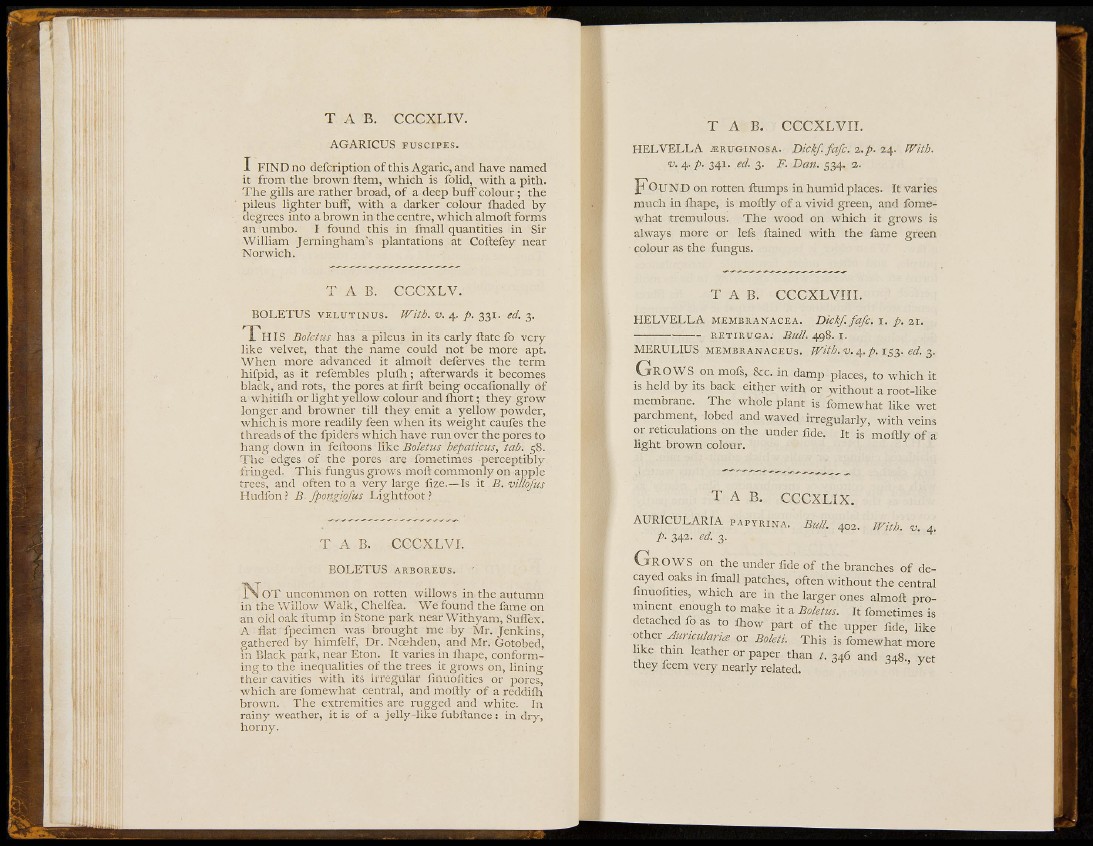
T A B . CCCXLIV.
AGARICUS FUsciPEs.
I FIND no defcription of this Agaric, and have named
it from the brown ftem, which is foUd, with a pith.
The gills are rather broad, of a deep buff colour ; the
pileus lighter buff, with a darker colour ihaded by
degrees into a brown in the centre, which almoft forms
an umbo. I found this in fmall quantities in Sir
William Jerningham's plantations at Coftefey near
Norwich.
T A B . CCCXLV.
BOLETUS VELUTINUS. With. v. 4. p. 331. ed. 3.
T H I S Boletus has a pileus in its early ftate fo very
like velvet, that the name could not be more apt.
When more advanced it almoft deferves the term
hifpid, as it refembles plaih; afterwards it becomes
black, and rots, the pores at firft being occafionally of
a whitilh or light yellow colour and ihort; they grow
longer and browner till they emit a yellow powder,
which is more readily feen when its weight caufes the
threads of the fpiders which have run over the pores to
liang down in feltoons like Boletus hepaticus, tab. 58.
The edges of the pores are fometimes perceptibly
fringed. This fungus grows moft commonly on apple
trees, and often to a very large fize.—Is it B. villofus
Hudfon ? B. fpongiofus Lightfoot ?
T A B. CCCXLVI.
B O L E T U S ARBOREUS. -
N^OT uncommon on rotten willows in the autumn
in the Willow Walk, Chelfea. We found the fame on
an oid oak ftump in Stone park near Withyam, Suffex.
A flat fpecimen was brought me by Mr. Jenkins,
gathered by himfelf, Dr. Ncehden, and Mr. Gotobed,
in Black park, near Eton. It varies in fliape, conforming
to the inequalities of the trees it grows on, lining
their cavities with its irregular finuoiities or pores,
which arc fomewhat central, and moflly of a reddifli
brown. The extremities are rugged and white. In
rainy weather, it is of a jelly-like fubftance: in dry,
horny.
T A B . CCCXLVII.
HELVELLA .«RUGINOSA. Dickf. fafc. i,p. 24. PVith.
V. 4. p. 341. ed. 3. F. Ban. 534. 2.
F O U N D on rotten flumps in humid places. It varies
much in iliape, is moftly of a vivid green, and fomewhat
tremulous. The wood on which it grows is
always more or lefs ftained with the fame green
colour as the fungus.
T A B . CCCXLVIII.
HELVELLA MEMBRANACEA. Dickf. faß. i. p. ai.
— RETIRUGA; Bull. 498. i.
M E R U L I U S MEMBRANACEUS. With. V. p. ed.
GROWS on mofs, &c. in damp places, to which it
is held by its back either with or without a root-like
membrane. The whole plant is fomewhat like wet
parchment, lobed and waved irregularly, with veins
or reticulations on the under fide. It is moftly of a
light brown colour.
T A B. CCCXLIX.
AURICULARIA PAPYRINA. Bull. 402. jvitb. V.
p. 342. ed. 3.
GROWS on the under fide of the branches of decayed
oaks in fmall patches, often without the central
finuofities, which are in the larger ones almoft prominent
enough to make it a Boletus. It fometimes is
detached fo as to ihow part of the upper fide, hke
-oth^r Auncularia or Boleti. This is fomewhat more
like thin leather or paper than 346 and 348., yet
they feem very nearly related.